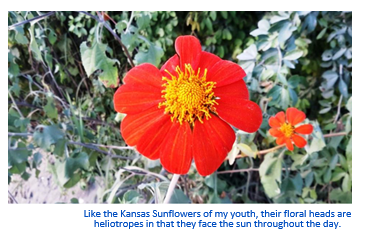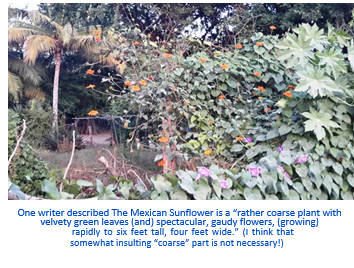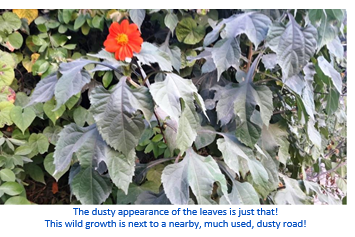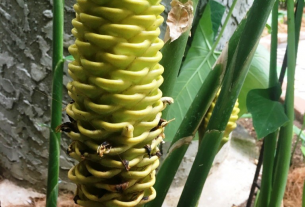By Tommy Clarkson on the March 2021 Edition
Mexican Sunflower Tithonia rotundifolia Family Asteraceae
Also known as Goldflower of the Incas, Red Sunflower or Mexican Marigold
 (Inasmuch as most of my regular readers and garden visitors know that, in fact, I was just an old Midwest US kid who enjoys rootin’ in the dirt, I’m going to name drop now! This morning, while returning from a leisurely, morning walk with my visiting buddy from Hawaii, Dr. Arthur Whistler – the renowned botanical author who is, in the guest bedroom below me, at this very moment, working on his seventeenth book on tropical plants and after whom no fewer than nine plants that he’s discovered have been named -glanced upon and commented on a Mexican Sunflower. Now these are not yet, technically, growing right here in Ola Brisa Gardens. But, they were seen close by and (though they are annuals) I may endeavor to start some specimens from seed for planting across the street. Besides that, I realized I’d not, heretofore, written about this attractive, ornamental wildflower. So, I decided to do so!)
(Inasmuch as most of my regular readers and garden visitors know that, in fact, I was just an old Midwest US kid who enjoys rootin’ in the dirt, I’m going to name drop now! This morning, while returning from a leisurely, morning walk with my visiting buddy from Hawaii, Dr. Arthur Whistler – the renowned botanical author who is, in the guest bedroom below me, at this very moment, working on his seventeenth book on tropical plants and after whom no fewer than nine plants that he’s discovered have been named -glanced upon and commented on a Mexican Sunflower. Now these are not yet, technically, growing right here in Ola Brisa Gardens. But, they were seen close by and (though they are annuals) I may endeavor to start some specimens from seed for planting across the street. Besides that, I realized I’d not, heretofore, written about this attractive, ornamental wildflower. So, I decided to do so!)
Firstly, as Art has properly described them in his book Tropical Ornaments, with their year-round blooming flowers are comprised of “large, terminal heads borne on thickened stalks, (with) each head surrounded by two series of ovate bracts with ray florets mostly (comprised of) ten to fourteen, obovate to elliptic, 1.5-3.3 cm (5/8-1 ¼ inches) long (and being) reddish-orange to yellow-orange” in color, the Tithonia rotundifolia does, indeed, look “sunflowery”!
In an article in Southern Living, I read of the Mexican Sunflower described as a “rather coarse plant with velvety green leaves (and) spectacular, gaudy flowers, (growing) rapidly to six feet (1.83 meters) tall, four feet (1.22 meters) wide.”
Kirsten Albrecht Llamas cites, in her excellent, large publication Tropical Flowering Plants, that there are ten to eleven species in the Tithonia genus, all being “annual and perennial herbs and shrubs from Mexico and Central America (with) floral heads (that) are rotate, solitary or in small clusters on long stalks.
She continues that they are “called mirsal (looks-at-the-sun) in Spanish, referring to the rotation of the floral head toward the sun (heliotropism) throughout the day.” (That sure sounds like the State flower of Kansas – where I spent my youth – to me!)
In a more functional description of it and its gardening uses, Neil Sperry says, in the second edition of Texas Gardening, “(it is an) “outstanding background plant but (is) quite coarse-textured for prime real estate spaces.” He adds that it (is) a delightful plant when used in moderation.”
 Susan Mahr, of the University of Wisconsin-Extension Service, did a masterful job of further plant-specific description saying that it has “a large central stalk and a somewhat gangly branching habit. The stems can be brittle.
Susan Mahr, of the University of Wisconsin-Extension Service, did a masterful job of further plant-specific description saying that it has “a large central stalk and a somewhat gangly branching habit. The stems can be brittle.
The dark green leaves are ovate to deltoid (triangular) in shape, with serrate to crenate margins. The coarse leaves are usually entire, but occasionally will be three lobed. The foliage and stems are covered with a soft, downy fuzz, and the underside of the leaves are hairy.”
She continues with “The solitary flowers are borne on fragile hollow peduncles (flower stems) that are susceptible to being bent and are often broken by birds. Each 3-inch blossom has a number of bright red-to-orange ray flowers surrounding the central yellow disk flowers.
The flowers are attractive to a wide variety of bees, butterflies (a particular favorite of Monarchs) and hummingbirds, and can be used as cut flowers. Deadheading spent flowers will prolong blooming.
The flowers are followed by grey-to-black flattened triangular seeds that are easy to collect, to save and to grow in subsequent years.”
This low-maintenance, heat-tolerant character grows best in full sun, with a medium amount of moisture. Interestingly, it prefers poor-to-average, well-draining soil in which to make its home. Relative to this, I’d suggest that one avoid planting them in rich soil or doing all that much fertilizing of them.
 Pinch back plants to encourage bushier growth and sturdier plants, otherwise they might fall over from being too top heavy and/or lacking sturdy-enough stalks. Even so, they often need to be staked to remain healthy looking and correctly upright. You also may want to shelter your Mexican Sunflowers from strong winds. But, you’ll be pleased to know they have few pest problems and that they reseed themselves generously!
Pinch back plants to encourage bushier growth and sturdier plants, otherwise they might fall over from being too top heavy and/or lacking sturdy-enough stalks. Even so, they often need to be staked to remain healthy looking and correctly upright. You also may want to shelter your Mexican Sunflowers from strong winds. But, you’ll be pleased to know they have few pest problems and that they reseed themselves generously!
In the “oh, by the way” category of facts, the genus is named for Tithonus, a young man much loved by Aurora, the dawn goddess!
—
Tommy Clarkson is a bit of a renaissance man. He’s lived and worked in locales as disparate as the 1.2 square mile island of Kwajalein to war-torn Iraq, from aboard he and Patty’s boat berthed out of Sea Bright, NJ to Thailand, Germany, Hawaii and Viet Nam; He’s taught classes and courses on creative writing and mass communications from the elementary grades to graduate level; He’s spoken to a wide array of meetings, conferences and assemblages on topics as varied as Buddhism, strategic marketing and tropical plants; In the latter category he and Patty’s recently book, “The Civilized Jungle” – written for the lay gardener – has been heralded as “the best tropical plant book in the last ten years”; And, according to Trip Advisor, their spectacular tropical creation – Ola Brisa Gardens – is the “Number One Tour destination in Manzanillo”.



